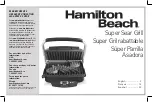
9 ENGLISH
Connecting lanyard (tether strap) to
the hook
CAUTION:
Do not use damaged hook and
screws. Before use, always check for damages,
cracks or deformations, and make sure that the
screws are tightened.
CAUTION:
Make sure that the hook is
securely installed with the screws.
CAUTION:
Do not install or remove any
accessory while hanging the tool.
The tool may fall
if the screws are not tightened.
CAUTION:
Always use a locking carabiner
(multi-action and screw gate type) and be sure
to attach the lanyard (tether strap) to the double
looped portion of the hook.
Improper attachment
may cause tool drop from the hook and result in
personal injury.
The hook is also used for connecting the lanyard (tether
strap). Be sure to connect the lanyard (tether strap) to
the double looped portion of the hook.
►
Fig.15:
1.
Double looped portion of the hook
2.
Lanyard (tether strap)
3.
Locking cara-
biner (multi-action and screw gate type)
OPERATION
CAUTION:
Always insert the battery cartridge
all the way until it locks in place.
If you can see the
red indicator on the upper side of the button, it is not
locked completely. Insert it fully until the red indicator
cannot be seen. If not, it may accidentally fall out of
the tool, causing injury to you or someone around
you.
CAUTION:
When the speed comes down
extremely, reduce the load or stop the tool to
avoid the tool damage.
CAUTION:
Hold the tool firmly when operat
-
ing the tool.
Holding tool
CAUTION:
This is a powerful tool. High torque
is developed and it is important that the tool
should be securely held and properly braced.
Grasp the handle with one hand and the front handle
with the other hand.
►
Fig.16:
1.
Front handle
2.
Handle
Drilling operation
Drilling in wood
When drilling in wood, the best results are obtained
with wood drills equipped with a guide screw. The guide
screw makes drilling easier by pulling the drill bit into
the workpiece.
Drilling in metal
To prevent the drill bit from slipping when starting a
hole, make an indentation with a center-punch and
hammer at the point to be drilled. Place the point of the
drill bit in the indentation and start drilling.
Use a cutting lubricant when drilling metals. The excep-
tions are iron and brass which should be drilled dry.
CAUTION:
Pressing excessively on the tool
will not speed up the drilling.
In fact, this excessive
pressure will only serve to damage the tip of your drill
bit, decrease the tool performance and shorten the
service life of the tool.
CAUTION:
Hold the tool firmly and exert care
when the drill bit begins to break through the
workpiece.
There is a tremendous force exerted on
the tool/drill bit at the time of hole break through.
CAUTION:
A stuck drill bit can be removed
simply by setting the reversing switch to reverse
rotation in order to back out. However, the tool
may back out abruptly if you do not hold it firmly.
CAUTION:
Always secure workpieces in a
vise or similar hold-down device.
CAUTION:
Avoid drilling in material that you
suspect contains hidden nails or other things that
may cause the drill bit to bind or break.
CAUTION:
If the tool is operated continuously
until the battery cartridge has discharged, allow
the tool to rest for 15 minutes before proceeding
with a fresh battery.
Lanyard (tether strap) connection
Safety warnings specific for use at height
Read all safety warnings and instructions.
Failure
to follow the warnings and instructions may result in
serious injury.
1.
Always keep the tool tethered when working "at
height". Maximum lanyard length is 2 m (6.5 ft).
The maximum permissible fall height for lan-
yard (tether strap) must not exceed 2 m (6.5 ft).
2.
Use only with lanyards appropriate for this tool
type and rated for at least 5.0 kg (11.0 lbs).
3.
Do not anchor the tool lanyard to anything on
your body or on movable components. Anchor
the tool lanyard to a rigid structure that can
withstand the forces of a dropped tool.
4.
Make sure the lanyard is properly secured at
each end prior to use.
5.
Inspect the tool and lanyard before each use
for damage and proper function (including
fabric and stitching). Do not use if damaged or
not functioning properly.
6.
Do not wrap lanyards around or allow them to
come in contact with sharp or rough edges.
7.
Fasten the other end of the lanyard outside
the working area so that a falling tool is held
securely.
8.
Attach the lanyard so that the tool will move
away from the operator if it falls.
Dropped tools
will swing on the lanyard, which could cause injury
or loss of balance.










































